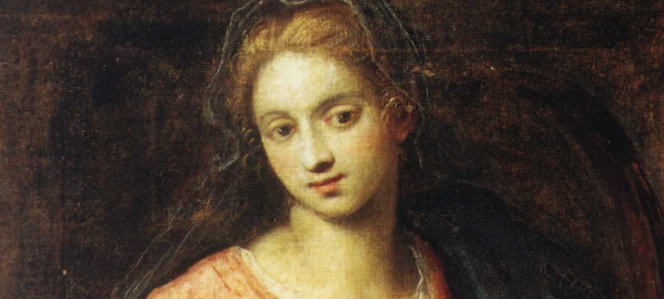Saint Lucy, whose feast the Church celebrates on December 13th, was a young Sicilian girl martyred in the midst of the Christian persecutions during the reign of the Emperor Diocletian in the early fourth century. St. Lucy’s story tells of her refusal to marry a pagan man to whom she was betrothed, desiring instead to offer her life to the service of the Lord and her dowry to the poor. The offended would-be bridegroom, after hearing of her refusal, denounced Lucy to the authorities as a Christian, who then ordered that her purity be defiled by sentencing her to work in a brothel. Legend has it that when the authorities arrived to carry her away to the brothel, she stood in her place, suddenly as heavy as a mountain, and was impossible to move, even by a team of oxen! The authorities then proceeded to torture her, to the point of plucking out her eyes with a fork, before taking her life. Because of this legendary account, the virgin martyr is most often depicted holding her eyes on a small golden plate and is invoked as the patron saint of blindness and ailments of the eyes.
The popular image of young St. Lucy, holding her very own dismembered eyeballs on a platter as she calmly and sweetly gazes up-and-to-the-left with the eyes of her glorified body, is an overwhelming, off-putting, often jarringly creepy image. While she stands as the embodiment of true vision, as the archetype of the spiritual understanding that focuses on Christ and His promises rather than grasping at the fleeting physical realities of this world, the peacefulness with which St. Lucy literally carries the evidence of her torture is a strange and uncanny paradox. The statues that line the walls at the Cathedral of St. John Lateran in Rome display this same disconcerting phenomenon—the Apostles of Christ are depicted holding the instruments and evidence of their martyrdom, St. Bartholomew carrying the flayed skin of his earthly face.
Obviously, this paradoxical peacefulness is indicative of an other-worldly grace, a supernatural strength given by God to the soon-to-be martyr. We know this, we categorize it as such, and we non-chalantly walk by these statues on our way to routinely receive the Eucharist, safely classifying them as “other worldly.” But their eyeballs indicate otherwise; their flayed faces and x-shaped crosses provide the link to our own world. The reality of their lives is made evermore present in the strange evidence of their deaths. They were challenged by their very physical nature— and they chose to use that nature to serve a spiritual purpose. In so doing, they were granted the peacefulness that characterized heavy-as-a-mountain, holding-her-own-eyes Lucy.
As we continue our journey toward Christmas, let us remember this great Advent saint and the manifestations of this same supernatural grace displayed by persecuted Christians in the Middle East. Let us starkly see the link between their world and our own, and let us prepare for the coming of Christ by welcoming in our own souls the other-worldly harmony that makes the Christian life so strange, off-putting, paradoxical… and beautiful.
